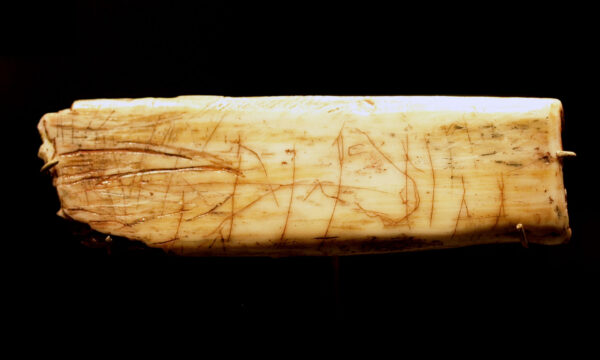 It is hardly surprising, but often the archaeological finds from the Palaeolithic that spark the most interest are things like figurines, paintings and engravings that have been discovered across the whole of Europe.
It is hardly surprising, but often the archaeological finds from the Palaeolithic that spark the most interest are things like figurines, paintings and engravings that have been discovered across the whole of Europe.
Although I can’t find any examples from Lincolnshire (probably due to lack of survival than lack of artistry), there are excellent examples at Creswell Crags, just over the border in Nottinghamshire. Within the caves are a number of carved drawings of animals such as reindeer, and also some birds. There have also been a small number of finds of portable art, including the Pin Hole Man carved onto a Woolly Rhinoceros bone and the Ochre Horse. Although the drawings are essentially outlines, they are often well-observed and accurately portrayed. It is also possible that they were decorated further in ways that have not survived the subsequence millennia.
And there is something amazing about them.
Look at flints and you see an artefact, a tool. When you look at the carvings and paintings of animals, you see what the carvers and painters saw. It is a unique insight into the life of a man or woman who is completely removed from our lives. It is a connection to our past.
Normally in heritage and archaeology, we are faced with the quite prosaic questions of what is it and how do we know? But art presents us with a very different set of very big questions, usually summed up in a single word – Why?
It is an intriguing question – why did hunter gatherers living in a harsh environment put time and effort into creating art?
In trying to answer this question we tend to be in an area where there is little hard physical evidence, and we have to look inwards. Why do we find things aesthetically pleasing? When do we turn to art in our lives?
It brings us to things we accept and seldom question – “All work and no play…” for example. We all of us have an underlying belief that the human condition is greater than fulfilling the need to survive. It is not an unreasonable speculation that our ancient ancestors were similar.
We cannot say that they were the same though. There is a term for that, it is called psychic unity. It refers to the idea that humans faced with the same problem will come up with the same solution because we have the same thought processes going through the same human brains. Recent advances in the study of neurology and psychology have suggested that human brains can actually operate in many different ways. You only have to look around at your peer group to realise that we don’t all think the same way.
But we do have things in common. Appreciation and expression of beauty and desire to interpret the world around us are things we have in common. Go anywhere in the world and you will find art, music and storytelling.
But are these just things to keep us amused?
I suspect not. I mentioned before the interplay of force and power. This pervades all aspects of life, including art. The capacity of an artist to interpret the world carries with it a certain amount of individual power. This is often utilised in modern societies by politicians patronising the arts, and attaching themselves to popular artists. The opposite is also true, art can be suppressed, produced against the will of the powers that be. These are themes that can be found throughout history.
In the Palaeolithic land of Lincolnshire, it may have been part of more personal relationships. The creation of a small portable piece of art is a highly controlled demonstration of force, and from that comes personal power. But it doesn’t stop there. Transferring a piece of art from one individual to another creates a link between the two and personal power starts to become collective power. Shared art, on a cave wall, becomes a collective resource and promotes greater collective power.
From their very first upright steps, humans have been complex, and social creatures that have not only existed within their environment, but they have tried to understand, interpret and modify that environment. The ancient tools we discover help us understand this process in a practical sense, how they hunted, what they ate, but ancient art helps us understand the rest of life.
And I am very firm in my belief that there is more to life than survival.
